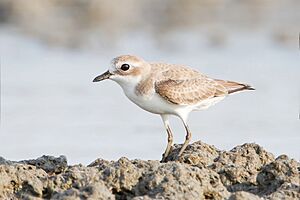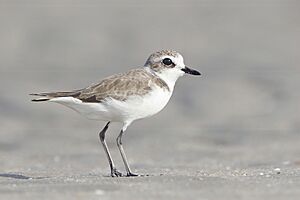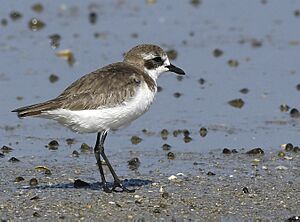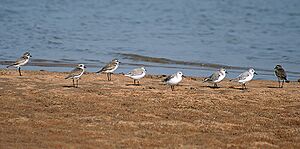Siberian sand plover facts for kids
Quick facts for kids Siberian sand plover |
|
|---|---|
 |
|
| Laem Phak Bia, Ban Laem, Phetchaburi, Thailand | |
| Conservation status | |
| Scientific classification | |
| Subspecies | |
|
|
| Synonyms | |
|
Charadrius mongolus (protonym) |
The Siberian sand plover (Anarhynchus mongolus) is a small bird that lives near water. It belongs to the plover family. These birds are known as waders because they often walk in shallow water to find food.
Scientists recently changed how they classify this bird. The International Ornithologists' Union decided to split the "lesser sand plover" into two different species. One is now called the Siberian sand plover. The name mongolus comes from Latin and refers to Mongolia, which was a larger area long ago.
Contents
How Scientists Group Them
The Siberian sand plover and the Tibetan sand plover used to be considered the same species. They were both part of what was known as the "lesser sand plover." This group had five different types of birds.
However, a study in 2022 showed something interesting. It suggested that the "mongolus" group (now the Siberian sand plover) is actually a close relative of the greater sand plover. Also, the "atrifrons" group (which is the Tibetan sand plover) is related to both of them.
|
Tibetan sand plover (the "atrifrons" group of lesser sand plover) |
|||||||
|
|||||||
This means that the "lesser sand plover" was not a single, clear group. Because of this, scientists needed to update their classification. They suggested new scientific names and common English names for these birds.
The larger birds from East Asia, called mongolus and stegmanni, are now known as the Siberian sand plover (Anarhynchus mongolus). The birds from the Tibetan Plateau are now called the Tibetan sand plover (Anarhynchus atrifrons). This group includes three types: atrifrons, pamirensis, and schaeferi. The IOU accepted these changes in 2023.
What Do They Look Like?
This plover is a bit chunky with long legs and a long bill. When it's breeding season, the male birds have grey backs and white undersides. Their chest, forehead, and the back of their neck are a chestnut (reddish-brown) color. They also have a black mask around their eyes.
The female birds are not as brightly colored. Young birds and those in winter do not have the chestnut color. They might have just a hint of reddish-brown on their head. Their legs are dark, and their bill is black.
These birds look very much like the greater sand plover, Charadrius leschenaultii. It can be hard to tell them apart. If you see them together, the greater sand plover is usually bigger. But if you see just one bird, it's much harder to know which one it is. The Siberian sand plover usually has darker legs, a white forehead, and a more even white stripe on its wing.
Where Do They Live?
Siberian sand plovers breed in different places across the bare coastal plains of north-eastern Siberia. The Mongolian plover type lives in the eastern part of this area. They have also bred in Alaska.
They make their nests on the bare ground. They lay three eggs in these nests. These birds are very migratory. This means they travel long distances. They spend their winters on sandy beaches in east and southeast Asia.
What Do They Eat and Do?
The Siberian sand plover eats insects, crustaceans (like small crabs), and annelid worms. They find their food by running a bit, then pausing, and then running again. This is different from some other wading birds that just keep poking their bills into the ground. When they are looking for food, they take fewer steps and pause for shorter times than the greater sand plover.
Their flight call is a loud, vibrating sound. The Siberian sand plover is one of the birds protected by the Agreement on the Conservation of African-Eurasian Migratory Waterbirds (AEWA). This agreement helps protect birds that migrate across Africa and Eurasia.
How to Tell Them Apart
It can be tricky to tell a Siberian sand plover from a greater sand plover. One way is their size; the Siberian sand plover is a bit smaller. However, it's hard to use size alone if you see only one bird.
The length of their bill is another clue. Siberian sand plovers generally have shorter bills than greater sand plovers. Also, the color of their legs can help. Siberian sand plovers usually have darker legs, from black to grey. Greater sand plovers have much paler legs, from grey to yellowish.





